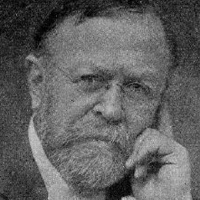Edwin J. Houston
Edwin James Houston was an American electrical engineer, academic, businessman, inventor and writer.
Edwin James Houston, a U.S. electrical engineer who influenced the development of commercial lighting in the United States.
Houston was born July 9, 1847, to John Mason and Mary (Lamour) Houston in Alexandria, Virginia. He graduated from Central High School of Philadelphia (a degree-granting institution rather than an ordinary high school) in 1864.[1] He received both his Bachelor of Arts and master’s degree from the same Central High School, where he then became professor of civil engineering for a short period before holding its chair of Natural Philosophy and Physical Geography. Princeton University awarded him an honorary doctoral degree. He also served as emeritus professor of physics at the Franklin Institute and professor of physics at the Medico-Chirurgical College.[2]
While teaching physics at Central High School in Philadelphia, he helped design an arc light generator with his former student colleague Elihu Thomson. Together, they created the Thomson-Houston Electric Company in 1882 which soon after moved to Lynn, Massachusetts.[
Houston collaborated with Elihu Thomson in experimenting on induction coils, dynamos, wireless transmission, and the design of an arc lighting system (patented in 1881) that was widely successful and led to further improvements in lighting techniques. The Thomson–Houston Electric Co., organized in 1883 at Lynn, Mass., merged with Thomas Edison’s company in 1892 to form the General Electric Company. In 1893 Houston was appointed chief electrician at the World’s Columbian Exposition in Chicago, where he implemented George Westinghouse’s two-phase alternating-current power system.
Thomas Davenport, an American inventor of what was probably the first commercially successful electric motor in 1834, which he used with great ingenuity to power a number of established inventions. The next year, Davenport used an electric motor to propel a small car around a circular track, the first recorded instance of an electric railway. In 1837 he received a patent for “Improvements in propelling machinery by magnetism and electromagnetism.”
Elias Howe, an American inventor whose sewing machine in 1846 that helped revolutionize garment manufacture in the factory and in the home.

Edwin J. Houston
Date of Birth: 09 Jul 1847
Birth Place: Alexandria, Virginia, United States
Proffession: American businessman
Nationality: United States
Death: 1 March 1914, Philadelphia, Pennsylvania, United States


